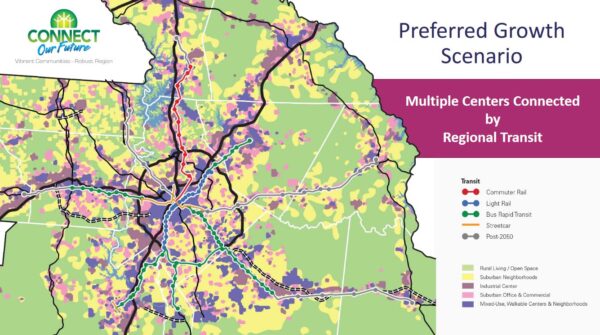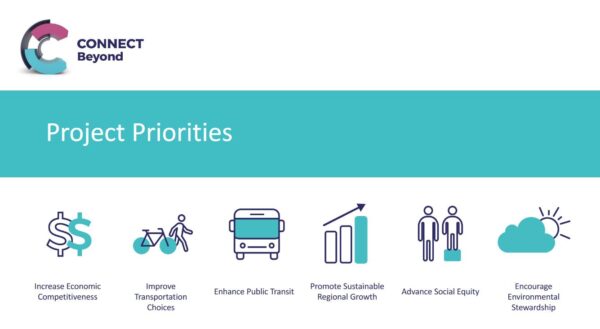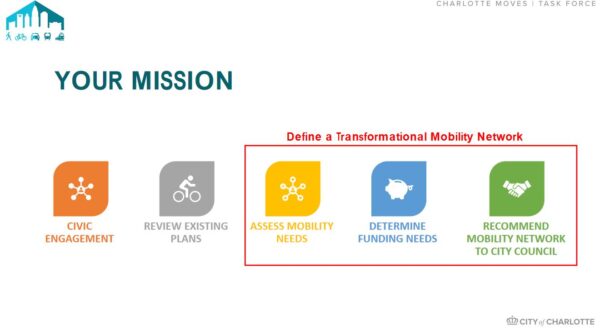Charlotte moves task force focuses on equity-based transportation planning
If you watched the first three Charlotte Moves Task Force meetings, you’ve likely noticed that they were primarily focused on educating the members about Charlotte’s many completed and in-progress transportation plans, policies, and processes. We’re excited that the August 20 meeting marked a shift in energy from learning to doing.
If you watched the first three Charlotte Moves Task Force meetings, you likely noticed that they were primarily focused on educating the members about Charlotte’s many completed and in-progress transportation plans, policies, and processes. We’re excited that the August 20 meeting marked a shift in energy from learning to doing.
Regional Transit Plan
People don’t live, work, and play only within city or county limits. Charlotte needs a mobility network with regional connections. Through the Centralina Council of Governments’ Connect Our Future project, thousands of residents in the 14-county region gave their input about how they wanted to see the region grow. The result? A preference for a growth scenario called Multiple Centers Connected by Regional Transit.

Building from the preferred growth scenario, Connect Beyond is an effort to define a single, coordinated vision for our region. It covers an area encompassing 2 states, 12 counties, and about 5,000 square miles. This process will also:
- Identify high capacity transit corridors that complement plans and infrastructure
- Strategize coordination opportunities
- Develop implementation tools

Geraldine Gardner from the Centralina Regional Council emphasized that this visioning effort will emphasize both “quick wins and bold moves” to help the Charlotte region advocate for the big transportation investments that will be needed to truly connect residents, as well as the policy advocacy in Raleigh that will be needed to bring the issue to voters.
Digging Deep on the Task Force Members’ Work
The task force members had homework last month, and we’d say they deserve an A+ for thoughtful effort! Working in pairs, they discussed and answered a number of questions.
Here are the key questions and short summaries of the major themes that emerged:
- What has been useful and insightful so far? They’re impressed with the existing transportation plans and conversation last month with representatives from peer cities.
- What’s been missing from the process? There’s still a need to consider costs of the coming investment, determine a “gameplan” after December, more consideration for “less flashy” transportation investments (bus, sidewalks, etc.), and address concerns that the mobility landscape is shifting constantly due to the pandemic and technology.
- What are the key priorities and goals for the task force? Regional Connectivity, Equity, Transportation Choices, and Growth Management.
Digging a bit deeper into the question of how “greatest need” is defined, task force members talked about expanding and enhancing the transit network, balancing “big ticket” and “quick win” investments, and balancing regional connectivity with “first and last mile” neighborhood-level connectivity.
Some members suggested focusing on the most vulnerable and least connected communities first, using a data-driven approach and making sure residents aren’t displaced as transportation investments make land in their neighborhoods more valuable. We agree that the entire planning and investment process needs to be equity-centered and account for unexpected negative outcomes on communities that are already marginalized, disconnected from transportation choices, or facing displacement pressure.
Transformational Mobility Opportunities
Former Mayor Harvey Gantt, who chairs the task force, asked the group a key question; “Do we present to the community something that really connects? Are we going to be constrained by cost? Will we get out front and say ‘This is worth the cost’?
He was asking them to dig into the definition of the word transformational and how that definition should guide the task force’s work between now and December.
This question led to a lively discussion about whether the task force should develop an aspirational plan first and then determine how to pay for it, or work towards a plan with cost constraints in mind.
Stephen Stansbery from Kimley-Horn, the consultant working on Charlotte’s Strategic Mobility Plan, reminded the task force members of their mission:

Now that the task force has spent several months reviewing existing plans, they’re reading to move into the hard work of defining a transformational mobility network and determining how to pay for it.
If this network is going to be truly transformational and equitable, it will need to expand and enhance Charlotte’s rapid transit corridors, create a bus priority system, build the greenway network, support pedestrian walkability, create a bicycle priority network, and improve safety and efficiency of the roadway network for all who use our streets.

Obviously, building light rail is expensive, takes a long time, and can disrupt communities in which tracks are laid. The city and region can’t be entirely served by rail within walking distance of every home and business. No city has such a network!
An exceptional bus network is therefore going to be a major key to the success of the Charlotte area’s transportation network. We need a network that prioritizes buses by providing more frequent service (more buses running more often), prioritization of buses on streets so they’re not getting slowed in traffic and ways for the people who ride buses to reach their stop by bike or on foot.
Stansbery emphasized the importance of creating a bicycle priority network for people of all ages and abilities. “If our network now only serves the fearless cyclists…we’re missing out on an opportunity to connect many people.”
What’s Next?
Mayor Gantt is assigning more homework to the task force members!
In advance of the September 17 meeting, he’s asking them to:
- Define transformational within the context of the task force’s work to recommend a mobility network.
- Help “fill up the buckets” of the various modes of transportation and investments in the network.
- Consider what outcomes and community benefits they’d expect to see 20 years from now as a result of investing in a transformational mobility network.
Our Take
We know that a transformational mobility network is one that genuinely meets the needs of all people to get around without having to drive a car. It needs to be aspirational, bold, and able to take on the challenges of our current car-centric culture. But we also recognize that every plan needs to have a price tag that taxpayers can afford. As several task force members pointed out, the investment needs to generate a good return for the people investing in it and not place an undue burden on those who are already struggling financially. If a reasonable amount of public investment can dramatically improve residents’ ability to live well without a car, then it will be quite worth it!
Our delegate on the task force, Eric Zaverl, shared some key insights during the comment period. He emphasized the importance of creating a vision that the public will get excited to invest in. We love the analogy he shared of baking a cake: If the right ingredients are present in the right amounts — the right benefits, the right cost, the right connectivity, and deeply grounded in equity — then voters are more likely to see value in supporting a new funding source for a transformational network.
Let the task force know what YOU think a transformational mobility network needs to include!
Tune into the next Charlotte Moves Task Force meeting at 6:00 pm on Thursday, September 17 on the City of Charlotte’s YouTube channel or Facebook page. Details here.
Submit your questions and comments to the task force by emailing charlottemoves@charlottenc.gov, commenting on the YouTube and Facebook videos, or calling 980-293-1245. The task force will address those questions and comments during their meetings.
Take the Charlotte Moves survey and share it with friends, neighbors, and colleagues.
View the presentations that were shown at the August meeting here. All images in this blog post were presented during the meeting.
Thanks for reading!
As a nonprofit, community support is essential for us to keep doing what we do — including providing free articles like this. If you found this article helpful, please consider supporting Sustain Charlotte.
Want to stay in the loop? Subscribe to our weekly newsletter and follow us on Instagram, Facebook, and Twitter.
